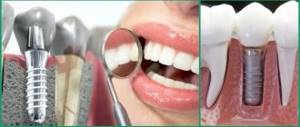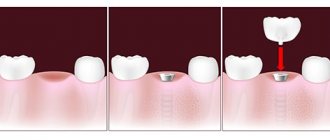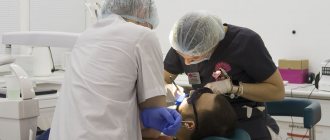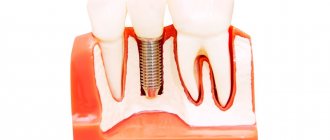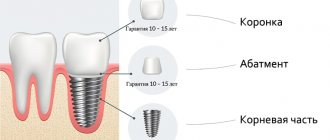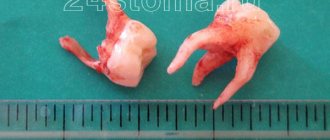Before deciding on dental implantation, patients want to know step by step how dental implants are placed.
The complete implantation procedure includes 3 stages:
- preparatory,
- surgical,
- orthopedic.
We have prepared a detailed description of each of them.
How are dental implants done today?
Almost all patients who decide to undergo this operation are concerned about the question of how dental implantation works. The procedure involves the following steps.
- An implant is placed in the prepared hole, then it is covered with a gum flap, sutured and wait until it integrates. Healing of the implant takes several months: about two or three - on the lower jaw, from four to five - on the upper jaw.
- A small circular incision is made in the gum and a gum former or abutment is installed on the implant and loaded with a temporary crown.
- Impressions are taken, a permanent crown is made and installed on the implant.
Immediately installing a permanent crown is not recommended, as it puts strong pressure on the implant, which leads to its rejection. The two-stage technique is ideal for smokers and patients who do not take good care of hygiene - bacteria will not be able to penetrate into the closed socket, and the risk of implant rejection will be minimized.
The two-stage method is most often used to restore already missing or traumatically removed teeth, when there is not enough bone tissue in the area where the implant is installed. In these common situations, bone volume needs to be increased. Sometimes this manipulation can be carried out simultaneously with the installation of the implant, but most often it is necessary to postpone the implantation for several months and wait until the required volume of bone tissue is formed.
The process of installing a dental implant before and after
Abutment installation
After the required volume of tissue surrounding the artificial tooth has been formed, the former is replaced with an abutment.
In general, the operation principle of manipulation is not very different from changing the plug. The only difference is that there is no need to make an incision into the gum tissue.
After installing the abutment, all preparatory work for the direct installation of the crown is completed.
In the video, watch the stages of one-stage classical implantation.
What are the latest dental implant technologies?
One-stage
Today, an implant can be installed in just one day. This modern technology is called one-stage implantation. Do not confuse it with one-stage, these are two fundamentally different methods. Single-stage implantation is carried out immediately after tooth extraction, and during a one-stage procedure, a temporary crown or gum former is installed simultaneously with the implant. The one-stage method is most often used when restoring the frontal group of teeth, so that the patient does not feel embarrassed about his smile. In addition, installing a temporary crown or former at the same time as the implant helps to correct the shape of the gums, which plays an important role in creating an ideal smile.
Together with tooth extraction
Single-stage dental implantation - how does it happen? Such an operation can be carried out only under ideal conditions: if the tooth was removed atraumatically, there are no inflamed hard and soft tissues left in the socket, and there is sufficient bone tissue present. If the conditions are unsatisfactory, bone material is poured into the hole, and after a couple of months, two- or one-stage implantation is performed. Moreover, in some cases, a one-step technique can become a one-stage one. For example, if the implant is installed into the bone with a certain force, and there is no severe inflammation in the patient’s oral cavity.
By template
New technologies for dental implantation, such as surgery using a surgical template, make it possible to correctly position implants in the oral cavity. Before the procedure begins, a special template is made for the patient, which is sent to the computed tomography department, where the template is scanned, and then the patient along with it. Next, the computer models are combined in a special program. The resulting stencil allows you to first work with aesthetics, that is, determine where the crowns or dentures will be placed, and only then place implants under them. This unique technology helps to achieve an excellent visual effect, accurately install implants even in areas with the minimum allowable bone volume, without affecting vessels and other anatomical formations, and also reduce the procedure time. Using a surgical template before dental implants is ideal for patients who are missing all or several teeth in a row.
Expert opinion
Emir Romanovich Omerelli
Maxillofacial surgeon, implantologist
Experience: more than 13 years
Basal dental implantation is the best way to restore the functionality of the dentition in patients with partial or complete absence of teeth, accompanied by acute atrophy of the jaw bone, as well as inflammation of periodontal tissue and the skeletal system. Classical dental implantation is the optimal method for replacing single dental defects. In case of complete edentia, the two-stage protocol is not suitable, since the installation of implants will require complex and voluminous expansion of the jaw bone, requiring long-term rehabilitation. By reducing the number of visits to the doctor and eliminating a number of procedures (for example, osteoplasty), basal implantation is significantly cheaper than a two-stage procedure.
How does implantation proceed from start to finish?
Let’s simulate a situation where the patient has previously undergone an examination and comes to the clinic directly for implantation. How does dental implantation proceed in this case? First, he is given anesthesia, local and not general. Even the longest operation does not take more than two hours and does not require such a serious type of anesthesia as anesthesia for dental implantation. Further, the procedure regulations depend on the type of implantation: if we are talking about a two-stage technique, then first the gum is cut, a hole is made in the bone, an implant is installed in it, which is covered with a flap, and then suturing is done. All of the above manipulations take no more than fifteen minutes. If the operation follows a template, then the installation of each implant takes no more than ten minutes, since no cutting of the gums or suturing is required.
Single-stage and one-stage implantations last a little longer, since they require either tooth extraction or the installation of a crown or gum former.
Technology for installing dental implants in pictures
Implants should be installed in a sanitized oral cavity, so visiting a therapist and hygienist will not be a bad idea. Consulting doctors are also competent in how dental implantation proceeds; they will treat caries and remove all dental plaque, thereby minimizing the risk of implant rejection.
Orthopedic
2 weeks after installing the base for the crown - the abutment - prosthetics are performed. The implantologist, together with the orthopedist, completely recreates the anatomical integrity of the dentition.
The following types of prostheses can be installed on an artificial root:
- fixed;
- removable;
- conditionally removable;
- combined.
Taking impressions
In order for craftsmen to make an individual prosthesis for the patient’s oral cavity, dentists take impressions using special material.
Before the final installation of the artificial tooth body, the structure is repeatedly tried on.
If necessary, its parameters are adjusted until the prosthesis no longer causes discomfort in the patient. On average, the production of a structure takes from 2 to 4 weeks.
Installation of the prosthesis
The subtleties of the process of installing a prosthesis depend on its type. Single crowns or 2-3 single bridge structures are attached directly to the abutment using adhesive material.
Installation of a prosthesis, which can replace almost the entire dentition, is carried out using special locks that are built into the crowns.
However, the cheapest method of fixation is to screw the tooth body into the implant using screws implanted into the prosthesis.
For details about the stages of classical implantation, see the video.
How many implants are needed and which ones to choose?
Installing ten implants on each jaw is an ideal solution for patients suffering from complete edentia. However, a good result can be achieved with eight or even six implants. More economical options are removable dentures on four implants. The most budget-friendly alternative is a removable denture on two implants. Some patients believe that two or four implants will not be able to withstand the load placed on them during jaw work and will be rejected. In fact, the pressure during chewing is distributed throughout the entire prosthesis and falls not only on the implants, but also on the bone and gum, so there is no need to fear rejection.
The choice of product depends, firstly, on the volume of bone tissue. If there is a lot of bone, then any implant can be installed, and if not, then only a certain size. Secondly, from the methodology. Thus, it is possible to carry out one-stage implantation only if the implant is tightly fixed in the bone. To do this, either its rod or thread must be of large diameter. Not all companies produce such aggressive implants, so the patient has not much choice. And thirdly, from the budget.
Reviews
Implantation is a universal method of restoring the integrity of the dentition, which in terms of cost is not suitable for every patient in a dental clinic. In addition, it is not a fact that your body will accept a foreign body.
Have you ever experienced implantation? How long did the prosthetics process take you in total? Are you satisfied with the result? Leave your comment. We are sure that your experience will be useful to many of our readers.
If you find an error, please select a piece of text and press Ctrl+Enter.
Do I need to follow certain rules after surgery?
After the procedure, you must follow all the specialist’s recommendations. In the first two to three days, you should not rinse your mouth in the area of the implant, since blood cells that promote its healing are washed out from the operated area. However, it is still necessary to clean the implant installation area, although very carefully. To do this, you can use special brushes with soft bristles and a paste with an antiseptic effect. For three to four days after the operation, you should not exercise, carry weights, or visit a sauna, bathhouse or solarium. And - most importantly - if any unpleasant or abnormal sensations occur, you must immediately contact your dentist. If you carefully care for the implant and follow all recommendations, it will last you a lifetime.
Rehabilitation period
Implantation is a prosthetic technique that requires a rehabilitation period. Often, the patient’s body recovers within 5 months.
All this time you must follow certain rules:
- Conduct preventive examinations at the dentist at intervals prescribed by the implantologist;
- during hygiene procedures, you should use a brush of medium hardness and apply minimal pressure of the bristles to the area subject to implantation;
- the use of aseptic rinses and waxed dental floss is prohibited;
- solid food intake should be kept to a minimum.
Who can undergo implantation and who cannot?
Implants cannot be installed in girls under eighteen years of age, and in boys under twenty-one years of age, since during this period the bone is still forming, and implantation can disrupt this complex process. As for the upper age limit, there is no upper age limit for installing implants. Absolute contraindications include disorders of blood clotting and bone regeneration. It is prohibited to perform the operation on pregnant women and people with an unbalanced psyche. In all other cases, implantation is possible.
Indications and contraindications for use
Thanks to implantation, it is possible to solve the problem of the absence of one or more teeth and various defects. The advantage is that there is no need to grind down adjacent teeth or remove nerves. The procedure helps restore the chewing apparatus in case of edentia.
Installation of supporting titanium implants allows you to create a permanent bridge structure. Implantation is also practiced by doctors for disorders of the dental system. It helps restore normal teeth closure.
However, the procedure also has contraindications for use:
- oncological diseases, malignant tumors;
- problems with the thyroid gland, immunodeficiency;
- pathologies of the nervous system, mental disorders;
- endocrine disorders, blood diseases;
- diabetes mellitus, metal intolerance.
The list of contraindications is quite wide. During diagnosis, the doctor will determine the possibility of dental implantation.
What is the cost of dental implants?
The process of dental implantation is quite complex, with many subtleties and nuances. Therefore, its price is appropriate. In dentistry, the minimum cost of a South Korean implant and its installation is 18,000 rubles. It comes with a five-year warranty, but with adequate care it will last you a lifetime. German implants are more expensive - from 30,000 rubles, but they have a lifetime guarantee. The cost of implants for a one-step technique is 36,000 rubles. The price list of premium level products starts from 42,000 rubles. Additional manipulations, such as bone grafting, are paid separately. Bone tissue augmentation costs from 18,000 rubles to 40,000 rubles, depending on the complexity of the operation. The cost of a temporary crown is 12,000 rubles, a permanent one - from 18,000 to 34,000 rubles. Dentures on implants cost from 64,000 to 190,000 rubles.
Planning
After analyzing the collected information, the implantologist evaluates the examination results and presents available treatment options. The patient receives information about possible alternative solutions, stages and timing of upcoming dental implantation. The cost of the treatment plan and prices depend on the number of implants, the brand of the manufacturer, and the characteristics of the clinical picture.
Diagnostics
Diagnostics is not only a consultation with a specialist and examination of oral tissues, but also includes instrumental and laboratory tests. Without them, no conscientious doctor will be able to set a date for the operation. During a comprehensive examination of the patient, it is possible to identify the presence of contraindications, for example, chronic diseases, oncology, tuberculosis, etc.
A panoramic photograph of the jaw is needed even with classic prosthetics; it allows you to assess the condition of bone tissue and joints, the location of the roots of the teeth, features of the bite and much more. This is a very important stage, because for successful engraftment and reliable fastening of the structure, it is very important to have a dense base. A CT scan is also mandatory; no other technique can replace this informative study.
If the slightest deviations from normal values are detected, a bone grafting procedure may be prescribed; also, based on the tests, the doctor decides what shape and size of implant is suitable for the job. Among the main tests are a general blood test, sometimes a biochemical test is additionally prescribed, as well as a hormone test (for women over the age of 50).
